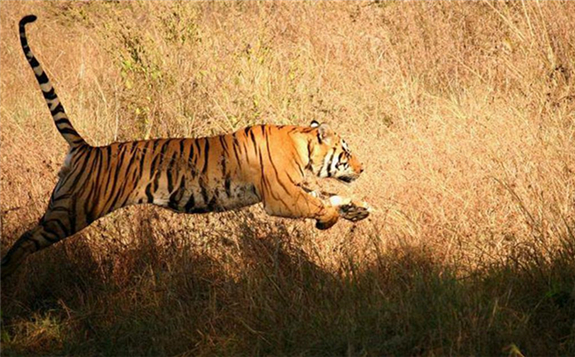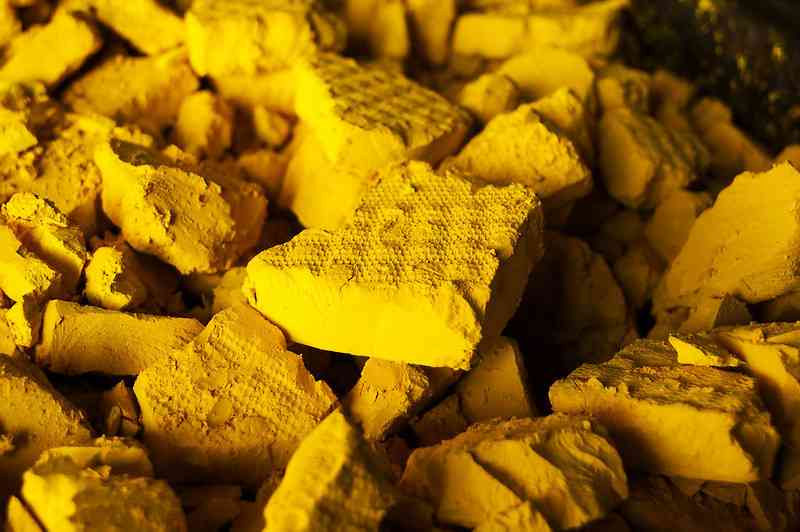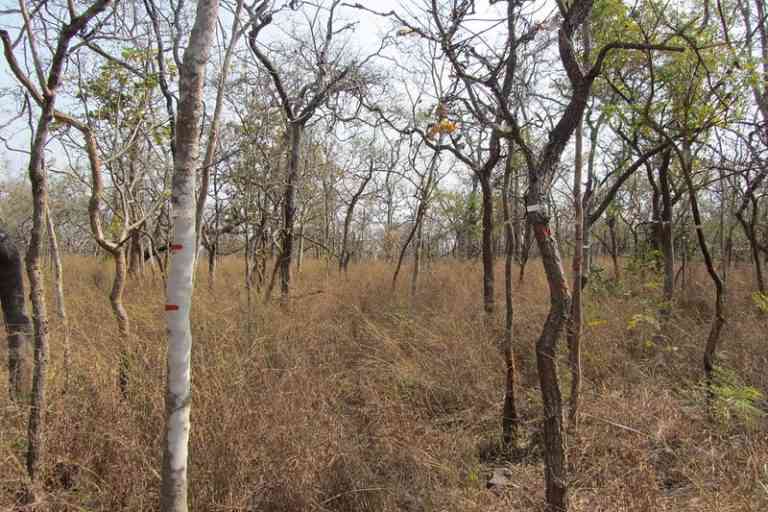Between protecting the interests of the tigers and Chenchu Adivasis and pursuing uranium mining in Telangana state, the former has won for now. The Atomic Minerals Directorate for Exploration and Research, Hyderabad under the Department of Atomic Energy has decided to “shelve” the project to drill boreholes in the Amrabad Tiger Reserve to prospect for the yellowcake, a form of uranium ore. Uranium is used as the basic fuel to generate nuclear power.
 It is estimated that the Amrabad Tiger Reserve has about 20 tigers. | Davidraju / Wikimedia Commons
It is estimated that the Amrabad Tiger Reserve has about 20 tigers. | Davidraju / Wikimedia Commons
In 2019, an expert panel on forests of the Ministry of Environment, Forest and Climate Change had recommended in-principle approval for a proposal by the Department of Atomic Energy for survey and exploration of uranium over 83 sq km in the tiger reserve.
However, facing opposition from environmental groups, conservationists and NGOs, the Telangana government and the state wildlife board consistently rejected the project during the last two years. The key grounds were the threat to the tigers and wildlife, water pollution, damage to the habitation where the Chenchu Adivasis reside and the long gestation period which was detrimental to the overall forest reserve.
 Yellowcake uranium, a solid form of uranium oxide produced from uranium ore. Photo credit: Energy Fuels Inc/ Nuclear Regulatory Commission/Flickr
Yellowcake uranium, a solid form of uranium oxide produced from uranium ore. Photo credit: Energy Fuels Inc/ Nuclear Regulatory Commission/Flickr
Consequently, the Atomic Minerals Directorate for Exploration and Research came to a final conclusion.
On March 15, its director DK Sinha, after a seminar on Radiation and Environment organised by the Indian Nuclear Society in Hyderabad, told the media that it has suspended plans of taking up survey and drilling of boreholes to estimate the uranium deposits in the Amrabad Tiger Reserve, as the state government is not in favour of the project due to public sentiment against it.
Chequered history
If one drives from Hyderabad, the core area of this tiger reserve, spread across 2,500 sq km would be about 125 km. It was originally part of the Nagarjunasagar-Srisailam Tiger Reserve, India’s largest tiger reserve.
Post the bifurcation of Andhra Pradesh in 2014, the Amrabad Tiger Reserve falls in Telangana and is the country’s sixth-largest tiger reserve.
It is part of the expansive Nallamalla forests, which are home to a large number of tigers and are also populated by Chenchu Adivasis, who are hunter-gatherers. The Amrabad Tiger Reserve harbours rich biodiversity with over 70 species of mammals and hundreds of plant varieties. The wildlife includes tiger, leopard, dhole, deer, striped hyena, jackal, nilgai, sambar, chowsingha and sloth bear to name a few.
It was sometime in 2015-’16, that the Atomic Minerals Directorate for Exploration and Research had first proposed the project to drill around 4,000 boreholes in select locations in the 83 sq km area of the Amrabad Tiger Reserve in Mahboobnagar district and also in neighbouring Nalgonda. Extensive surveys carried out by the Atomic Minerals Directorate for Exploration and Research had shown the prospects of an estimated reserve of over 20,000 tonnes of the mineral.
The Atomic Minerals Directorate for Exploration and Research approached the state government for the necessary clearances. The state wildlife board recommended it to the Union Ministry of Environment, Forests & Climate Change for permission with a clear condition that even if the presence of uranium was confirmed, mining will not be allowed at any cost.
After a lull, in 2018, the Atomic Minerals Directorate for Exploration and Research came up with a fresh proposal and some modifications. In May 2019, the Atomic Minerals Directorate for Exploration and Research got an “in principle” nod from the Forest Advisory Committee of the environment ministry to conduct surveys in the Amrabad Reserve Forests. It even went ahead with preliminary work.
The Telangana Wildlife Board, which was in limbo after 2016 was reconstituted only towards the end of 2019. As resistance to the mining project grew, the Wildlife Board held two meetings in 2020, the latest being in October. At both meetings, the Board rejected the project proposal on three main counts.
According to it, the first reason was that the prospecting and work expected to take five years will impact the wildlife, especially the tigers and their entire habitat. Secondly, being close to the catchment area of river Krishna and Dindi, drilling could pollute the water and affect the lives of the Chenchu Adivasis. Thirdly, the project was rejected under the Forest Conservation Act, 1980.
The Atomic Minerals Directorate for Exploration and Research’s plans had moved to the Amrabad Reserve after its efforts in Lambapur-Peddagattu faced stiff resistance. The area located in the politically sensitive Nalgonda district is also inhabited by Banjara Adivasis. These Adivasis, over the decades, have become more empowered. The district also is a strong base for politically left parties. All of them were against the uranium mining project.
The NGOs and environmental groups with political backing also put pressure on the Telangana state government forcing Chief Minister K Chandrasekhar Rao to announce his government’s opposition to the uranium mining projects. Rao said his government is against uranium mining in Amrabad Tiger Reserve and has no intention to allow the Nallamalla forests (where the tiger reserve is) to be destroyed.
“It will contaminate the Krishna river from which we get drinking water,” the chief minister had said in the State Assembly in 2019. “It will impact our capital city Hyderabad. So at any cost, we will not allow uranium mining. This is our firm decision. I request the people of the state not to worry about it.”
 The Atomic Minerals Directorate for Exploration and Research has decided to ‘shelve’ the uranium mining project in the Amrabad Tiger Reserve, Telangana. Photo credit: Jayashree Ratnam, Oregon State University/Flickr
The Atomic Minerals Directorate for Exploration and Research has decided to ‘shelve’ the uranium mining project in the Amrabad Tiger Reserve, Telangana. Photo credit: Jayashree Ratnam, Oregon State University/Flickr
With these developments piling up, the Atomic Minerals Directorate for Exploration and Research finally decided to drop the uranium mining project here.
According to Sinha, the director of Atomic Minerals Directorate for Exploration and Research, the decision by the atomic energy body will be a loss to Telangana State. It has several other mining-friendly states who are welcoming them like Rajasthan and Jharkhand, he said. Telangana will no longer be a “focus” state for the Atomic Minerals Directorate for Exploration and Research.
Instead, a second project with an investment of around Rs 700 crores is being planned at Tummalapalle in Andhra Pradesh. The notification for a public hearing regarding the same will be issued in three months, he added.
The Atomic Minerals Directorate for Exploration and Research carries out surveys, prospecting for uranium reserves across the country. Over the past three decades, it has established reserves in Jharkhand, Rajasthan, Meghalaya, Andhra Pradesh and Bihar. It found promising zones in the Nagarjunasagar area and Kadapa in the united Andhra Pradesh State as highly potential locations more than 15 years ago.
Subsequently, it proposed mining in Tummalapalle in Kadapa and Lambapur-Peddagattu, close to the Nagarjunasagar reservoir in Nalgonda districts. The then chief minister, YS Rajasekhara Reddy managed to get the project through in his home district of Kadapa. The Department of Atomic Energy has successfully operationalised a mining-cum-production facility a few years ago. The Uranium Corporation of India Limited, Ranchi in Jharkhand, the mining arm of the Department of Atomic Energy has taken up the full-fledged project for exploitation of the resource in Andhra Pradesh.